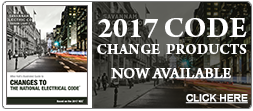Conductor Sizing and Protection
By Mike Holt [ based on the 2011 NEC ]
The National Electrical Code requirements for conductor sizing and overcurrent protection have always been confusing and complex. Factors that must be considered include:
- Continuous loads
- Terminal temperature ratings
- Conductor insulation
- Conductor ampacity
- Conductor bundling
- Ambient temperature
- Special application
NEC 240.4 requires the branch circuit, feeder, and service conductors to be protected against overcurrent in accordance with their ampacities as specified in 310.15. Section 240.4(A) through (G) contains rules that modify the general requirement and permit conductors to be protected in a manner other than their ampacities from 310.15, including:
- Power Loss Hazard [240.4(A)]
- Overcurrent Devices Rated 800A or Less [240.4(B)]
- Small Conductors [240.4(D)]
- Tap Conductors [240.4(E)]
- Transformer Secondary Conductors[240.4(F)]
- Air-Conditioning and Refrigeration Equipment Circuit Conductors [240.4(G)]
- Capacitor Circuit Conductors [240.4(G)]
- Electric Welder Circuit Conductors [240.4(G)]
- Fire Alarm System Circuit Conductors [240.4(G)]
- Motor-Operated Appliance Circuit Conductors [240.4(G)]
- Motor and Motor-Control Circuit Conductors[240.4(G)]
- Phase Converter Supply Conductors [240.4(G)]
- Remote-Control, Signaling, and Power-Limited Circuit Conductors [240.4(G)]
With so many different Code rules that modify the general requirements, it does become overwhelming to select a circuit conductor and overcurrent protection device. However the following steps and examples should help you understand the basic rules of conductor sizing and protection.
Step 1 - Size the overcurrent device in accordance with 210.20(A) and 215.3. These two NEC rules require the overcurrent device (breaker or fuse) be sized no less than 100% of the noncontinuous load, plus 125% of the continuous load.
Step 2 - Select the conductor to comply with 210.19(A), 215.2, and 230.42(A). Sections 210.19(A), 215.2 and 230.42(A) require the conductor to be sized no less than 100% of the noncontinuous load, plus 125% of the continuous load.
In addition, 110.14(C) requires consideration of the temperature rating of the equipment terminals when sizing conductors. Circuit conductors must be sized according to the 60°C column of Table 310.15(B)(16) for equipment rated 100 amperes and less, unless marked otherwise, and equipment rated over 100 amperes must be sized to the 75°C column of Table 310.15(B)(16) [110.14(C)]. The purpose of this rule is to insure that the heat generated on equipment terminals can be properly dissipated without damaging the conductors. For all practical purposes, most electrical equipment is design to accept conductors sized to the 75°C column of Table 310.15(B)(16).
Step 3 - The selected conductor must be protected against overcurrent in accordance with 240.4. This requires the branch circuit, feeder, and service conductors be protected against overcurrent in accordance with their ampacities as specified in Table 310.15(B)(16).
Branch Circuit Continuous Load Example
What size branch-circuit overcurrent protection device and conductor (THHN) is required for a 23A continuous load (75°C terminals).
Step 1 - Size the overcurrent protection device in accordance with 210.20(A) - The branch-circuit overcurrent protection device must be sized not less than 125% of 23A.
23A x 125% = 28.75A or 30A [240.6(A)]
Step 2 - Select the conductor to comply with 210.19(A), which requires the branch-circuit conductor to be sized no less than 125% of the continuous load, 23A x 125% = 28.75A. The conductor is selected to the 75°C temperature rating of the equipment terminals in accordance with Table 310.15(B)(16). In this case, 10 THHN having a rating of 35A at 75°C is suitable.
Step 3 - We must ensure the conductor is protected against overcurrent in accordance with the requirements of 240.4. Again in this case, 10 THHN (from Step 2) rated 35A [Table 310.15(B)(16) is protected by the 30A protection device.
Feeder Continuous Load Example
What size feeder overcurrent protection device and conductor (THHN) is required for a 184A continuous load on a panelboard (75°C terminals).
Step 1 - Size the overcurrent device in accordance with 215.3. The feeder overcurrent device must be sized not less than 125% of 184A, 184A x 125% = 230A. According to 240.6(A) we must select a minimum 250A overcurrent device.
Step 2 - Select the conductor to comply with 215.2, which requires the feeder conductor to be sized no less than 125% of the continuous load, 184A x 125% = 230A. We must select the conductor according to the 75°C temperature rating of the panelboards terminals [110.14(C)] - 4/0 THHN has a rating of 230A at 75°C will meet this requirement.
Step 3 - Verify the conductors selected in Step 2 is properly protected against overcurrent in accordance with 240.4. The 4/0 AWG conductor from Step 2 is rated 230A at 75°C, it is permitted to be protected by a 250A protection device in accordance with the "the next size up rule" of 240.4(B).
Free Commercial / Industrial Wiring and Raceway Chart
[ Click here for more information on Mike's Conductor Sizing - Homestudy Programs ]






 Products
Products Cart
Cart